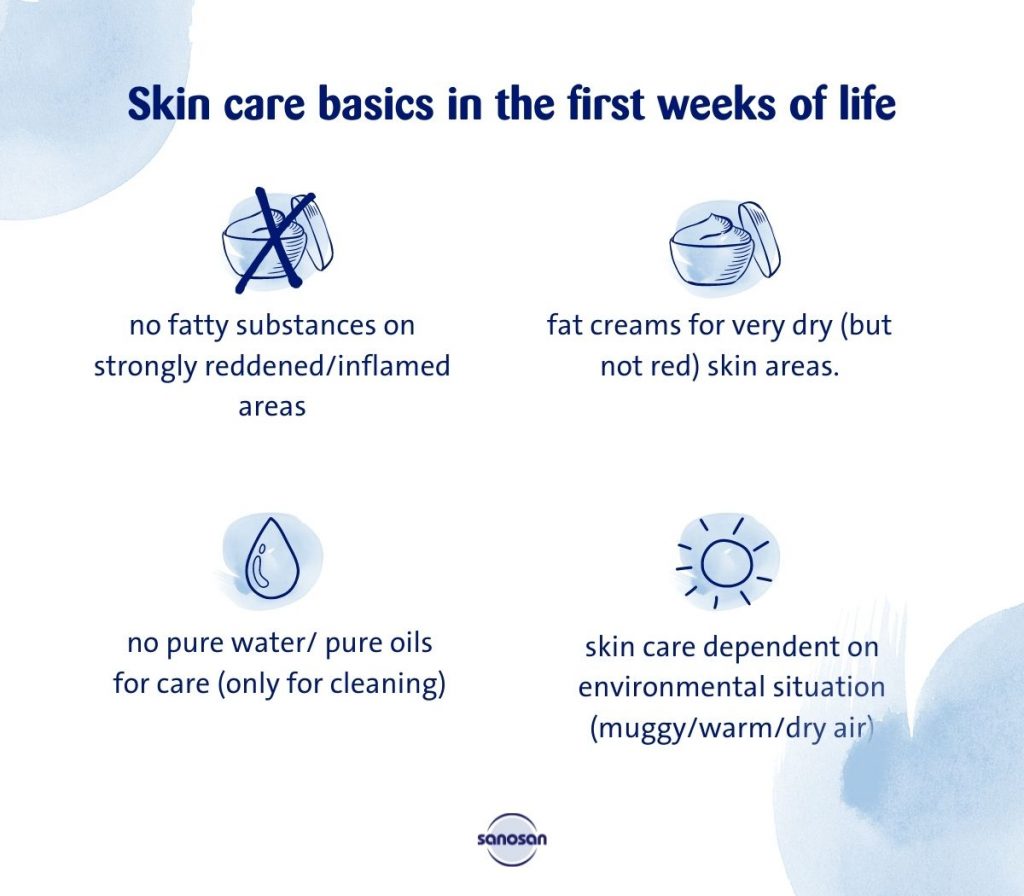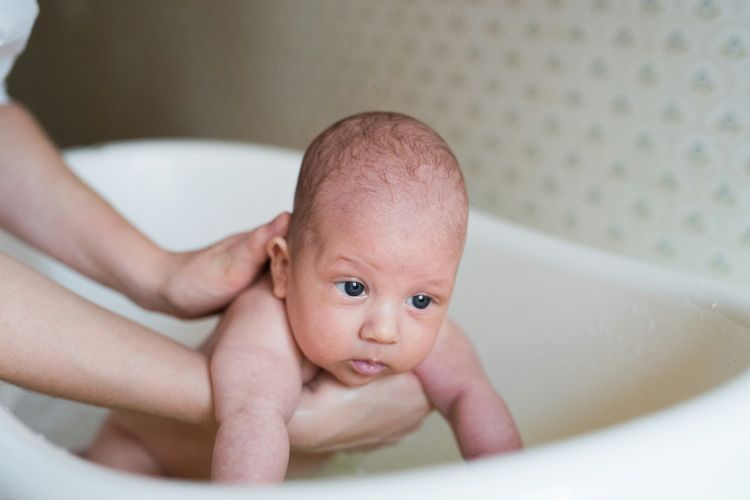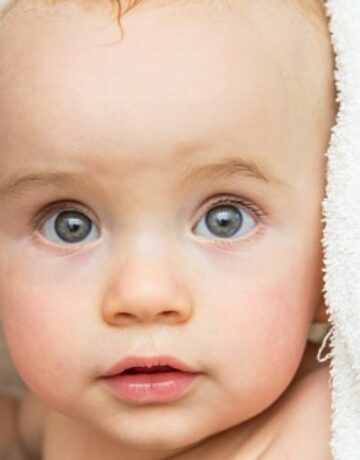Cleansing and caring for baby’s skin – From head to toe
This article was written by Dr. Pleimes, a specialist in pediatrics, dermatology, and allergology.
Learn more about Dr. Pleimes here.
Baby skin is far more sensitive and delicate than adult skin, requiring special attention during cleaning and care. In this article, you’ll learn which skincare products are suitable for your baby, how to clean the navel and other body areas, and what to consider for your baby’s first bath.
Your baby’s skin in the first weeks of life
When your baby is born, their skin is still very sensitive. Due to the thinner and less stable outer skin layer, moisture is lost more quickly from the deeper layers, leading to faster drying of the skin. This is especially noticeable in winter when the air is drier. Additionally, the upper and lower skin layers are not yet as well connected as in older children, making the skin more prone to injury from friction. In the last trimester of pregnancy, sebum production increases and continues for some time after birth. This, along with the vernix caseosa (cheesy coating) present at birth, likely helps protect your baby from drying out too quickly. However, this can also lead to an increased tendency for pimples in the early days. Before birth, the baby resides in a sterile environment but is exposed to various microorganisms during delivery. This is completely normal and harmless but can also cause some babies to develop small pimples on their skin. If you want to learn more about skin changes in the first months of life, read this article.
Principles of baby skincare
Rich creams or oils can worsen certain skin conditions, such as newborn acne, in the first two months. Skincare should always be adapted to the current situation. Generally, lighter products with a higher water content are more suitable in the first 1–2 months, with richer products introduced later if needed.
Key rules for baby skincare:
- Avoid applying rich substances to highly inflamed or red areas.
- Very dry but non-red areas respond well to richer creams.
- Use pure water or oils only for cleaning, not for skincare. Oils can sometimes dry out the skin or maintain its current dryness without improving it.
- Adapt skincare to environmental conditions: In humid, warm summer weather, the skin needs less fat than in dry winter air.
The skin of very premature babies may require different care depending on the week of gestation. Always consult the specialists caring for your child for guidance.

The development of the navel
After birth, a small portion of the umbilical cord remains attached to the navel, typically secured with a clamp. Over the first few days, this stump darkens, dries out, and eventually detaches, usually by the end of the first week, though it can take up to two weeks. While waiting for the stump to fall off, keep the area dry and clean. In Germany, many midwives recommend delaying the first bath until the stump has fallen off. However, this varies across cultures, and bathing beforehand is generally possible.
Cleaning the navel
- Wash your hands thoroughly beforehand.
- Use warm (max. 37°C) boiled water and a clean, damp compress to gently clean the area.
- Pat the navel dry afterward.
- Place a sterile gauze pad under the stump to protect the underlying skin.
- Ensure diapers sit below the navel to avoid irritation.
- Never attempt to remove the stump prematurely by pulling it.
Once the stump has fallen off, keep the area clean and dry.
Baby’s first bath
When the umbilical stump has fallen off, the first bath can take place. Use water and, if desired, a mild cleanser suitable for baby skin.
Preparing for the first bath
- The bathwater should be 36–37°C, checked with a thermometer.
- Limit bath time to 5–10 minutes.
- Bathe your baby about twice a week if the skin is healthy, though daily baths are also possible.
- Use separate soft washcloths for the face and body.
After bathing, dry your baby quickly by wrapping them in a towel and gently patting them dry. Avoid rubbing, as this can strip protective fats from the skin.
Skincare products
Choose products with only necessary and high-quality ingredients. Avoid:
- High levels of fragrances, mineral oils, or parabens.
- Plant-based ingredients (e.g., from the daisy family) that can cause contact allergies with regular use.
- Antibacterial additives unless specifically recommended for a skin condition, as they can irritate the skin or damage its barrier.
For cleansers, opt for products specifically designed for sensitive baby skin. Adjust the type of cream or lotion based on your baby’s skin condition and the environment:
- Use lighter, water-based products for irritated or red skin and warm, humid weather.
- Switch to richer, oil-based products for dry skin in cold, dry climates or for older babies (from 2–3 months).
Cleaning specific body areas
The face and diaper area may need to be cleaned in addition to the twice-weekly bath. If a bath is planned, facial care for the eyes, ears, and nose can be done beforehand.
Cleaning your baby’s face
Use cotton pads or soft gauze compresses soaked in lukewarm water.
Eyes
Clean from the inner corner outward, using a new pad for each eye.
Nose
Wipe around the nostrils to remove crusts or mucus.
Ears
Wipe behind and around the outer ear with a clean pad. Never insert anything into the ears or nose.
Genital area
Use lukewarm water and cotton pads. For stubborn dirt, add a small amount of mild cleanser. Always rinse off cleansers thoroughly.
Cleaning your baby’s penis
Gently wash your baby’s penis and scrotum with warm water and a cotton pad. Dry the penis and scrotum by patting them gently with a soft towel. The inner area of the foreskin and the glans do not need special cleaning, as the foreskin is usually too tight to retract. A milky-white substance (called smegma) may accumulate under the foreskin. This consists of dead skin cells and natural secretions and is nothing to worry about. Never attempt to forcefully pull the foreskin back over the glans, as this can cause injuries, scarring, and adhesions. In most cases, the issue of a tight foreskin resolves naturally during the first few years of life.
Cleaning your baby’s labia
Diaper creams, sweat, and secretions can accumulate around and between the labia. Generally, you only need to clean the area around the labia to remove stool residue. To clean your baby’s labia, moisten a cotton pad with lukewarm water. Gently separate your baby’s legs and use the cotton pad to carefully wipe between the labia, moving from front to back (toward the anus). Use a new cotton pad if you need to wipe again. Dry your baby’s genital area by patting it gently with a soft towel.
Stubborn stool residue can also be loosened with a small amount of oil or cream, making it easier to remove. Sometimes, newborn girls may have a slight, thick, milky discharge. This does not need to be removed. However, always discuss any unusual findings with your midwife or pediatrician. Occasionally, the skin folds in the groin, the perianal area, or the skin around the genital area may become slightly irritated. After gentle cleaning, applying a thin layer of a soft, zinc-based cream is recommended.
Diapers
The choice between cloth and disposable diapers depends on personal preference. While cloth diapers are more sustainable, they retain moisture against the skin, which can lead to irritation. Disposable diapers with super-absorbent properties are often better for healing irritated skin. Even if baby care feels challenging at first, don’t worry—you’ll quickly get the hang of it. Caring for your baby will become an enjoyable bonding experience for both of you!




Comments (0)